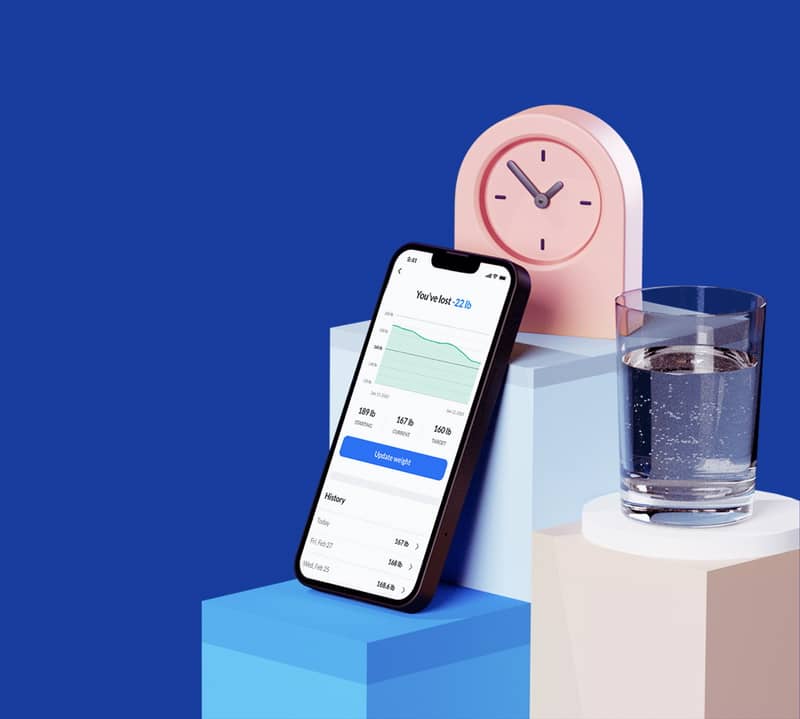DoFasting vs. Noom: Which One Is Really the Best?

How do we vet brands and products? Learn more.
Most people have accrued a slew of bad habits over the years that can be tough to break – and no amount of people chanting “eat fewer calories” and “get more exercise” is likely to change that.
That being said, those words – as frustrating as they can be to hear over and over – contain more than a little bit of truth. For most people, the solution to their weight loss problems lies somewhere between following a new, healthy diet and sticking to an exercise routine.
Of course, while breaking your eating habits is easy on paper, it is much tougher in practice. Most diets fail within the first few days or weeks simply because they are not comprehensive enough and do not cater to your individual weight loss needs.
Fortunately, you do not have to apply for entry to a weight loss program or adhere to some generic diet in order to lose weight and stay healthy. All you need is a diet app, one which caters to your needs in order to maintain a sustainable weight loss journey.
There are two diet apps of particular note here, both of which have worked well for plenty of people in the past. We are going to take a look at both of these fantastic diet apps and see what they have in common and, more importantly, what makes them unique.
What Is the DoFasting App?

Your Personal Intermittent Fasting App
- Progress tracker and calendar
- Calorie tracker
- More than 5,000 healthy recipes
- Training routines
- Daily motivation and tips
- Water intake targeting
- Daily caloric intake tracker
The DoFasting app is an intermittent fasting app that functions similarly to other apps of its kind. Working off of a (fasting) timer, the app tells you when to eat and when to fast, with the express purpose of helping you lose weight.
The actual infrastructure of DoFasting is relatively simple and easy to navigate. It projects and tracks your progress and includes how much time you spent fasting per day. Additional metrics – such as daily nutrition tracking statistics and your overall weight loss progress – are also available at any time.
Arguably the most useful “passive” feature that the DoFasting app includes is a persistent graph that shows your past and present weights, along with your target weight. Most users will highly appreciate this graph, as it displays a visual representation of their journey and can provide a much-needed boost to motivation in times of doubt.

In addition to these features, the DoFasting app also includes a separate array of features specifically dedicated to providing you with motivation. Needless to say, these features are a welcome addition to any diet app but seem especially useful here.
Fasting is a challenging diet plan that many people struggle to follow through with. The first few days or weeks of an intermittent fasting diet are especially tough to the uninitiated, so having these motivational features on hand is a huge benefit to users.
The DoFasting app also includes a variety of different meal ideas and exercise routines. The meal suggestions have been specifically curated to work in tandem with the app’s fasting program, and each one includes an extensive assortment of nutritional information and preparation instructions.
The suggested exercise routines have also been carefully selected to fit in with the rest of the program. They mainly focus on bodyweight exercises and can be completed quickly without any additional information. This is particularly useful to people who have no interest in dedicating themselves to a gym.
Overall, the DoFasting app is simple on the whole but also comprehensive enough to make fasting that much easier and more efficient, even for total newcomers.
What Is the Noom App?
Noom is another diet app, of which the structure differs greatly from DoFasting. However, it loses a lot of depth in covering as wide an area as possible.
Noom curates a specific diet unique to each user, based on said user’s answers to a series of questions. The app then breaks down all of your calories into different groups of fats, carbs, and proteins. In order to help you adhere to the guidelines laid out to you, the Noom app features a barcode scanner that allows you to view the nutritional information of everything you eat or drink.
Scanning the barcodes of the things you eat also highlights one of Noom’s other useful features. The app color codes basic food and drink items according to their nutritional value. Green is for healthy foods, and red is for unhealthy foods.
Eating more green foods will improve the results of your diet while eating red foods will have the opposite effect. This feature is useful for immediately identifying “problem” foods at a glance and allows you to make more informed decisions about buying groceries for the month ahead.
Arguably one of the Noom app’s most popular features is access to a personal health coach. You would do well to correspond with your health coach on a regular basis – they can be contacted during the working hours of every weekday, and you can give questions and seek advice when necessary. Your health coach is also a fantastic source of inspiration when it is sorely needed.
Is Noom an intermittent fasting app?
While Noom can aid you in your intermittent fasting goals to an extent, it is important to note that the app is more of a general dieting tool. As such, it is tough to recommend if you are following an intermittent fasting diet plan.
If you are interested in intermittent fasting, DoFasting is a much better option, with more streamlined features designed to help you towards achieving your intermittent fasting goals.
How Does DoFasting Work?
As previously mentioned, DoFasting features a simple app infrastructure that tracks your progress, including how much time you spend fasting. In general, the app is far more passive than Noom (which makes it far less intrusive) and includes a fasting tracker and calorie counting.
However, its motivational and more “active” features can be accessed at any time.
Additionally, DoFasting does not allow for any integration with other apps. Thankfully, it does not need to. The app is comprehensive all on its own, and all of your intermittent fasting needs will be accounted for.
How Does Noom Work?
Noom goes to great lengths to involve and engage its users as much as possible. New users are immediately presented with a questionnaire, and the answers they provide will shape their experience in a way that suits their specific needs.
The barcode scanner is also a tremendously helpful tool that further promotes user interactivity. It allows users to see the nutritional information of almost any food product, which comes in especially handy when grocery shopping.

Finally, Noom also encourages users to keep in close contact with their personal trainer. This provides a great source of motivation, encouragement, and advice, and can make all the difference in ensuring that users adhere to their weight loss program.
How Much Does DoFasting Cost?
The DoFasting app is a paid service and features three separate payment plans. Naturally, a yearly subscription ($67) will save you plenty of money, but the three-month plan ($39) is well-suited for those who are not ready to commit to a year’s worth of intermittent fasting.
Additionally, you could opt for a six-month subscription, which costs $52.
How Much Does Noom Cost?
Like DoFasting, the Noom app features a flexible payment plan and numerous pricing options, which are suggested to users based on the answers to the questionnaire and their personal weight loss goals.
Granted, these prices may still be steep for some users, but the number of features that you have access to may well be worth it to people who are dedicated to making healthy lifestyle changes.
Are They Worth the Money?
While both dieting apps have their fair share of positive features, it is clear that only one is worth your money when it comes to intermittent fasting.
We are, of course, referring to DoFasting. Its streamlined structure and design make it easy to approach and use every day. The calorie intake and fasting trackers provide a fantastic visual representation of your progress and can really boost your motivation levels.
DoFasting vs. Noom: Comparison Table


Intermittent fasting-focused app infrastructure
Fasting tracker
Calorie-intake tracker
Variety of meal plans and recipes
Assortment of simple exercise routines
Motivational features
Infographic displaying user progress
Focused on helping users with any and all diets
Barcode scanner which displays the number of calories in every food item
In-depth questionnaire which dictates the best weight loss program for you
Access to a personal trainer
Array of meal plans and exercise routines


Intermittent fasting-focused app infrastructure
Fasting tracker
Calorie-intake tracker
Variety of meal plans and recipes
Assortment of simple exercise routines
Motivational features
Infographic displaying user progress
Focused on helping users with any and all diets
Barcode scanner which displays the number of calories in every food item
In-depth questionnaire which dictates the best weight loss program for you
Access to a personal trainer
Array of meal plans and exercise routines
How to Choose
Choosing a dieting app is an incredibly important decision for those who want to dedicate themselves to losing weight and living a healthy lifestyle. As such, we always base our recommendations on a specific selection of important criteria:
- Medical relevancy – Are the product and its features backed by research?
- User experience – Is the product easy and pleasant to use?
- Reputation – Does the product have a good reputation?
- Professional involvement – Has the product been properly assessed by qualified professionals, and are those professionals still involved?
- Price – Does the product have a fair price attached to it?
In this case, DoFasting succeeds on every level.
A Word From Our RD
Intermittent fasting is one of the easiest and most effective ways of losing weight. There are a few things you should know before going in, though.
Firstly, understand that intermittent fasting – and subsequently, losing weight – is not a competition. Take everything in your own time, and know that you will get the results you want in due course.
Secondly, cravings are inevitable, especially during the beginning stages of an intermittent fasting diet. Understanding the root of your cravings will allow you to curb them in the future.
Cravings are often habitual and the result of your body’s expectations for what to eat and when. They are not a reflection of your willpower. That being said, your body will need plenty of time to readjust to your new diet. This leads on to our third point.
Supplements can help you a lot during the early stages of a new diet. The best ones contain glucomannan, which is a 100% natural dietary fiber. Its water-absorbing properties promote a feeling of fullness, with zero added calories.
With these thoughts in mind, and with the help of your chosen app, your intermittent fasting journey will be made that much easier.
FAQs
Below is a brief selection of some of the most frequently asked questions regarding intermittent fasting.
Simply put, intermittent fasting is a diet that promotes weight loss through fasting at small, disparate intervals throughout the day. You can find out more about this diet here.
Intermittent fasting is definitely worth a look if you are searching for a simple yet effective weight loss regime. It can be difficult to get into, but it is otherwise completely safe and hugely beneficial to your health. If you are struggling with an intermittent fasting diet, however, there are many other fasting diets to choose from.
While both apps have several great features between them, DoFasting is a much better choice when it comes to intermittent fasting and is more than worthy of your money.
Conclusion
It is clear to see that while both DoFasting and Noom are helpful apps in their own right, DoFasting is definitely the way to go when it comes to choosing a dieting app. Thanks to its abundance of features and flexible prices, users who take the time to try it out will be more than pleased and impressed.







Comments (0)